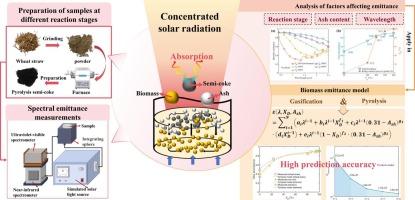Experiment and modeling study of particle spectral emittance in concentrated solar biomass thermochemical conversion
IF 6.9
2区 工程技术
Q2 ENERGY & FUELS
引用次数: 0
Abstract
The integration of solar thermochemical conversion with biomass gasification offers significant potential for achieving high-efficiency solar-to-chemical energy conversion. The thermal radiation characteristics of biomass directly influence its ability to capture and utilize solar radiation; however, previous studies often simplified biomass as a gray body, neglecting the complex physicochemical transformations occurring during pyrolysis and gasification that substantially alter its radiative properties. To address this gap, this study employed a self-developed platform for indirect emittance measurement to investigate three biomass samples. Samples representing different reaction stages of pyrolysis and gasification were prepared, and their spectral emittance was measured across the solar radiation waveband (0.3–2.5 μm). The results indicate that as the pyrolysis temperature increased, the total solar absorptance of biomass samples increased sharply from 0.49 to 0.90, thereby significantly enhancing their radiative absorption capacity. Ash content exhibited a pronounced inhibitory effect on emittance, particularly during gasification, where the high-ash wheat sample (29.44 %) displayed the lowest emittance. During gasification, all samples maintained high absorption capacity, with the emittance ranged from 0.87 to 0.93 in 0.3–2.5 μm. Based on the observed influences of reaction stage, ash content, and wavelength on emittance, two sixth-order emittance models were developed for pyrolysis and gasification. These models achieved low prediction errors of 1.20 × 10−3 and 4.05 × 10−5, respectively. This study provides valuable insights into the thermal radiative behavior of biomass and supports more accurate modeling of solar-driven pyrolysis and gasification processes.

聚光太阳能生物质热化学转化中粒子光谱发射度的实验与建模研究
太阳能热化学转化与生物质气化的结合为实现高效的太阳能-化学能源转化提供了巨大的潜力。生物质的热辐射特性直接影响其捕获和利用太阳辐射的能力;然而,以往的研究往往将生物质简化为灰色体,忽略了热解和气化过程中发生的复杂的物理化学转化,这些转化实质上改变了其辐射特性。为了解决这一差距,本研究采用自主开发的间接发射度测量平台对三个生物质样品进行了研究。制备了代表热解和气化不同反应阶段的样品,并测量了它们在太阳辐射波段(0.3 ~ 2.5 μm)上的光谱发射度。结果表明,随着热解温度的升高,生物质样品的太阳总吸收率从0.49急剧增加到0.90,从而显著增强了其辐射吸收能力。灰分含量对发射率有明显的抑制作用,特别是在气化过程中,其中高灰分小麦样品(29.44%)的发射率最低。气化过程中,各样品均保持较高的吸附能力,在0.3 ~ 2.5 μm范围内的发射度为0.87 ~ 0.93。根据反应阶段、灰分含量和波长对发射度的影响,建立了热解和气化的两种六阶发射度模型。这些模型的预测误差较低,分别为1.20 × 10−3和4.05 × 10−5。这项研究为生物质的热辐射行为提供了有价值的见解,并支持对太阳能驱动的热解和气化过程进行更准确的建模。
本文章由计算机程序翻译,如有差异,请以英文原文为准。
求助全文
约1分钟内获得全文
求助全文
来源期刊

Applied Thermal Engineering
工程技术-工程:机械
CiteScore
11.30
自引率
15.60%
发文量
1474
审稿时长
57 days
期刊介绍:
Applied Thermal Engineering disseminates novel research related to the design, development and demonstration of components, devices, equipment, technologies and systems involving thermal processes for the production, storage, utilization and conservation of energy, with a focus on engineering application.
The journal publishes high-quality and high-impact Original Research Articles, Review Articles, Short Communications and Letters to the Editor on cutting-edge innovations in research, and recent advances or issues of interest to the thermal engineering community.
 求助内容:
求助内容: 应助结果提醒方式:
应助结果提醒方式:


